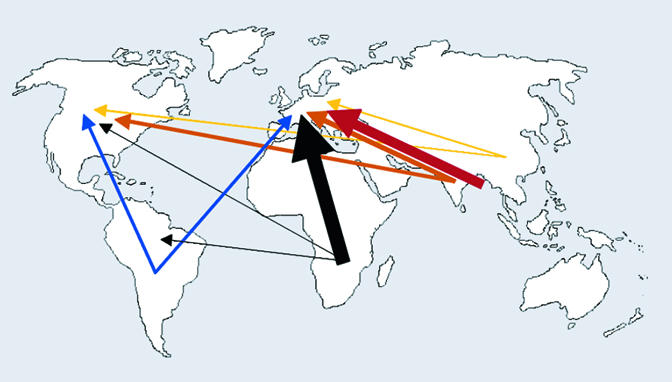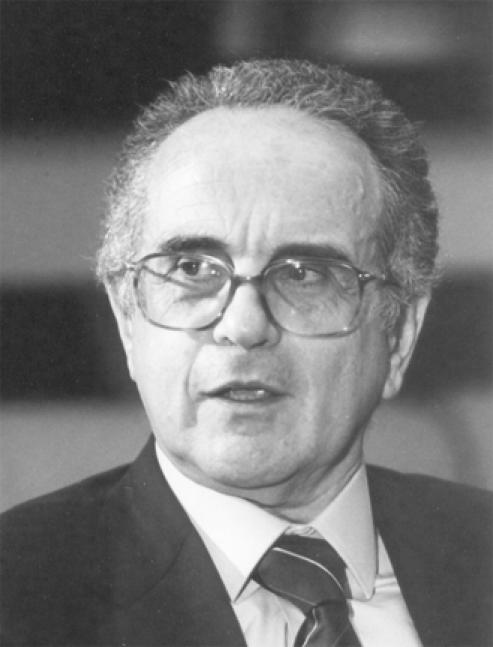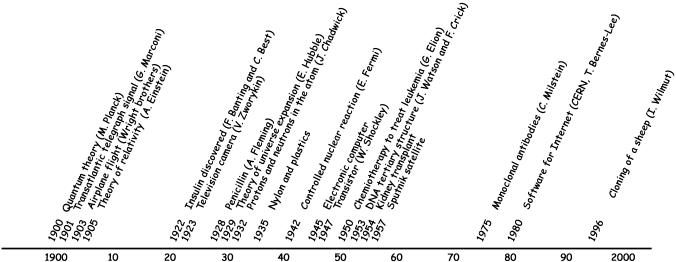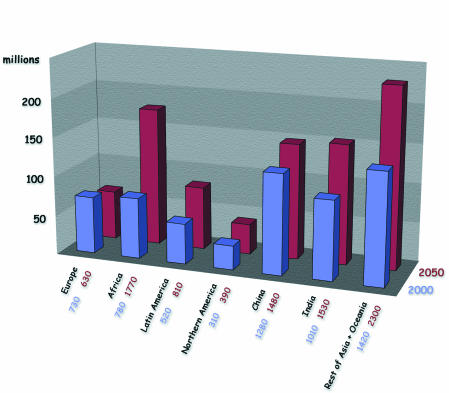Modern science has its beginnings in Europe with the natural philosophy of Galileo Galilei and Sir Isaac Newton at a time when scientific theories became independent of the constraints of religion and theology. Moreover, with the foundation of scientific academies (notably the Accademia dei Lincei, the Royal Society and the Académie des Sciences) Europe returned to the ancient Greek ideal of a place where thoughts and theories could be exchanged without restriction. Since the 16th century, European science has been flourishing, largely because of its close ties with the humanities in a multicultural society.
Scientific research and technological advances have made Western Europe one of the strongest economic powers on the planet. But a changing world, particularly population growth in the Third World, is creating hitherto unknown problems for European politics and society. To maintain its social and economic security, Europe will have no choice but to address and ultimately resolve these challenges. Science and technology will play an important role in this process, and the problem is that, unlike the USA, the EU has no long-term strategy or vision of how to pursue research and use this knowledge on a European scale.
Scientific research has led to remarkable innovations and has been of great benefit to humankind. Many discoveries of the last century have radically changed our way of seeing the world and have influenced our daily life (Figure 1). Life expectancy has increased strikingly due to improvements in public health and cures for many diseases. Agricultural output has risen significantly to meet the needs of a growing population. Technological advances and the use of new energy sources have freed humankind from arduous labour. More recently, new methods of communication and information processing have given rise to a new revolution. Innovation and improvement in all sectors is increasingly characterised by bi-directional feedback between the basic research system funded by the government and applied R&D in industry. Indeed, the relative amount of industrial research has been increasing in OECD countries, which shows that science is becoming more important for industrial development.
Fig. 1. Important discoveries of the 20th century.
Europe’s research is still excellent if we take the number of Nobel prizes awarded for natural science as an indicator: 50% of the laureates come from Western Europe. Moreover, more than one-third of the world’s scientific publications come from Western Europe, which has even increased its share during the last decade. The small number of Nobel laureates (only 13) and the low share of scientific publications from Eastern Europe does not reflect the excellent scientific expertise in these countries, and this may be the consequence of the hitherto closed nature of their scientific systems. Although Eastern Europe is currently undergoing a difficult transition, it is reasonable to assume that the proximity of Western and Eastern Europe will provide the potential for future strengthening.
As good as this may look, science policy in Europe is neither harmonised nor does it have a long-term vision. France, Germany and the UK together spend 60% of the total amount dedicated to R&D in the EU, and have a well-defined national research policy. However, no single country can take on the leadership on its own: at present, priorities for scientific research in the EU are decided at the national level and Europe-wide priorities follow the principle of complementarity. Support at the European level is granted if scientific co-operation represents an added value, as in the case of projects that are beyond the possibilities of a single country, or for economy of scale, or to complement the expertise of different countries. Approximately 13% of European research is financed by the EU or by intergovernmental programmes, while the remaining 87% is funded by the member states through autonomous decisions and without real co-ordination.
The EU is the largest economic market and has the largest Gross National Product in the world. Include the current EU applicants (Bulgaria, Cyprus, Czech Republic, Estonia, Hungary, Latvia, Lithuania, Malta, Poland, Romania, Slovak Republic, Slovenia and Turkey) and its population increases to 540 million, and the GNP to US$ 8900 billion. Indeed, the EU has the critical mass to perform long-term research that can contribute to the solution of social problems of world-wide impact. However, the economic power of the EU is not translated into political decision-making regarding science and technology. The EU and the USA spend about the same amount on R&D, but in the USA the funds are more focused and therefore more efficiently spent. Furthermore, Western Europe currently spends 1.8% of its Gross Domestic Product on R&D, compared with the 2.4 and 2.9% spent by the USA and Japan, respectively. This would be an acceptable level if the decision had been based on an informed discussion. Instead, not only the media, but also most politicians affirm that spending on R&D should increase. This paradox indicates the need for a discussion at the highest political level.
Europe must make a commitment to a long-term strategy for the funding and management of scientific research. Such a vision must take into account the necessity of basic human needs, such as energy, food, health, water, and even the availability of mineral resources—bearing in mind the environmental impact these decisions may have.
The EU depends on imports of important mineral resources of strategic value. At the same time, energy requirement is likely to increase in the future, thus making Europe more dependent on imports of foreign oil and coal. At present, Europe accounts for about 20% of the energy consumption worldwide, while it produces only about 65% of the energy it consumes.
World food production will have to double by the year 2050 to ensure sufficient quantity and quality, not only to meet the requirements of an increasing population, but also as a result of increasing urbanisation and spending power. Future technologies in crop production will play a decisive role in increasing yields. Although the EU is presently self-sufficient in terms of food production, it needs to maintain security in this sensitive field which is of strategic importance, as many wars of the past have demonstrated.
The health service of a nation is important for the well-being of its citizens. But equally important is the prevention and cure of emerging diseases. Following the discovery of antibiotics and the overall improvement of living conditions, the second half of the 20th century saw significant reductions in morbidity and mortality. However, microbes constantly evolve and become resistant to antibiotics, while non-pathogenic bacteria or viruses may become pathogenic. In a world where more than 80% of the human population lives in conditions of poor hygiene, while at the same time the ease and speed of transport are increasing the chances of contagion, the probability is very high that a new plague much worse than AIDS will emerge.
For the EU, water is not so much a problem of availability, but of distribution, treatment and pollution. According to the WHO, approximately one million people in Europe die every year from water-borne diseases. Droughts have affected large areas of Europe over the past decades and have had serious impacts, including water supply problems, quality deterioration, crop and livestock losses, pollution of ecosystems and extinction of animal species. They have also led to desertification in the south of Europe.
When dealing with Europe’s future, we should also keep the rest of the world in mind. Figure 2 shows that the population of Europe will decrease, both in absolute and relative terms through 2050, while the global population will increase by 50% to nine billion. This will pose major challenges for Europe. One result will be massive immigration. Figure 3 indicates that this will seriously affect Europe, since it is close to those continents where most of the population growth is taking place.
Fig. 2. World population projections. Source: UN Population Division, medium scenario, 1998.

Fig. 3. Future immigration trends (arrow thickness indicates the possible extent of immigration).
Another consequence of the population growth will be conflicts generated by poverty and by the lack of basic human staples, such as food and water. War and internal conflicts in the 1990s forced 50 million people to flee their homes. Chronic lack of food, according to the Food and Agriculture Organization of the UN, affects 826 million people in the world. Europe represents only 13% of the world’s population and this percentage will decrease: how can we hope to survive in the face of a massive upheaval in developing countries? How can we cope with the problems generated by massive immigration from our close borders with Africa and Asia? I believe that it is an imperative for the EU to be prepared. The solution to these problems rests not with insularity and restriction, but rather with the socially equitable development of the Third World. Science and technology have been—and will continue to be—major factors for industrial development and economic growth, and one priority for Europe should be to become the driving force of economic development in developing countries. This can only happen if science and technology are strengthened in these countries and if the EU can contribute, through the transfer of knowledge and assistance, to improving the educational systems.
As I pointed out earlier, the EU does not have a long-term policy for its own R&D and until now has only dealt with scientific co-operation and the mobility of scientists. Although discussions on the political future of the EU are not finalised, it is advisable that the Heads of State and Government ask the Commission to elaborate such a long-term vision. We should engage in a new phase that goes well beyond a simple reorganisation of the present scientific activities and instead both elaborate on them and implement new strategies.
In the USA, a long-term vision for science policy is usually identified with the book by Vannevar Bush, Director of the White House Office of Science, Research and Development. ‘Science—The Endless Frontier’, published in 1945, defines ‘basic’ research—at that time called ‘fundamental’ or ‘pure’ research—and its relationship to applied or industrial research. Bush stated that both basic and applied research should be financed according to the social needs of the nation, such as the war against diseases, national security and public welfare. Although its main proposal was the creation of the National Science Foundation, the book is considered in the USA as the seminal text on a national science policy. Whenever the US national policy had to be adjusted to the changing needs of the nation, for example, when the strategic research initiative was launched at the time of President Nixon, reference was made to Bush’s book.
Of course, Europe is different from the USA. It is much more diverse on the political level and also from a cultural point of view. When we draft priorities for European research, we must keep in mind that such a vision must convince the electorate, namely explain if and why scientific research is in the interest of all citizens. I believe that the key to such a discussion is the word ‘security’, namely a long-term investment in science and technology to contribute to the achievement of security in different fields. Science is essential to maintain national security—today even more than it was in the past. Long-term investment into research will give us the sophisticated technology to deal with the problems that I laid out earlier.
Such a public debate should address strategic security, namely investment in know-how that gives leadership in defence technology, and also co-operation with neighbouring countries to strengthen their science and technology system and therefore their economies. To achieve social security, we must invest in studies on the European way of life and on peaceful interactions between different cultures. Finally, we must make sure that basic human needs, such as energy, food, health and water, are satisfied, not only in Europe but also in the rest of the world.
In conclusion, it is time to begin discussing what the public expects from science. If the general areas discussed above are to be covered by a strategic vision for science in the EU, the next step will be to discuss how to identify and include specific topics in this general framework and how to implement them through science education and the establishment of research infrastructures. I propose that the European Commission prepares a document to be widely publicised and discussed at all levels in the 15 EU member states. Later on it should be discussed, and eventually approved, by the Heads of State and Governments. Science is important for economic and industrial development, and discussion on a long-term vision should not wait until the European Institutions have been defined. In fact, discussions leading to a European vision of science and technology in the future could contribute to indicating the needs and means for further integration.

Footnotes
This text is an elaboration of a speech given at the ministerial conference: ‘Science and Society’ organised by the Prime Minister of France in November 2000. I wish to thank Howard Moore for useful discussions.




